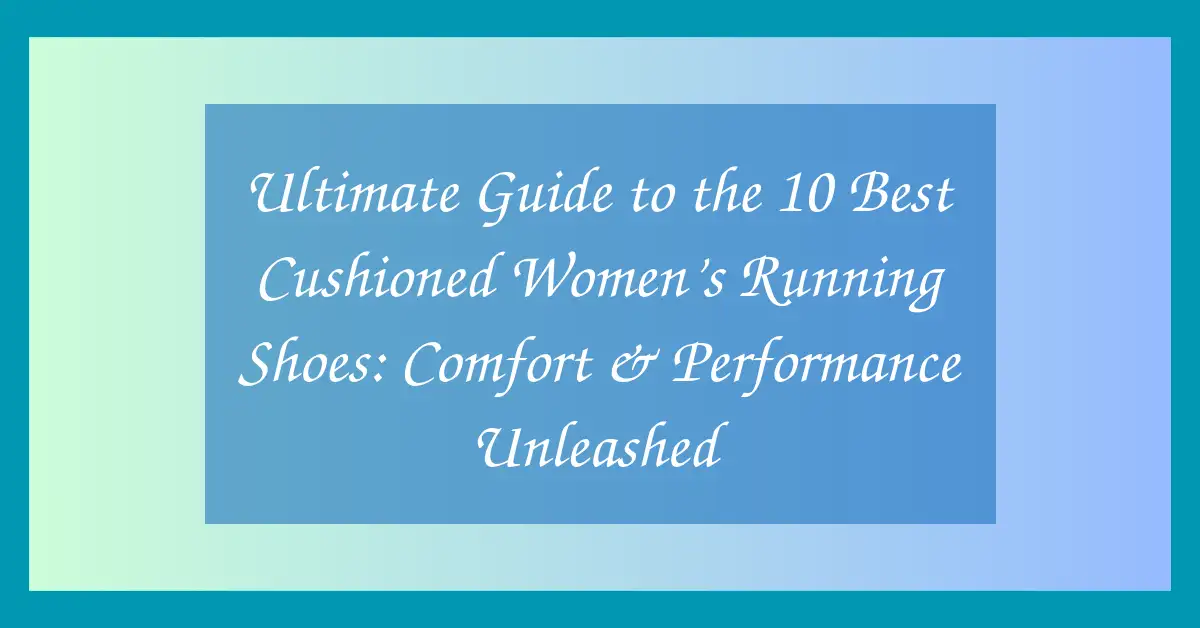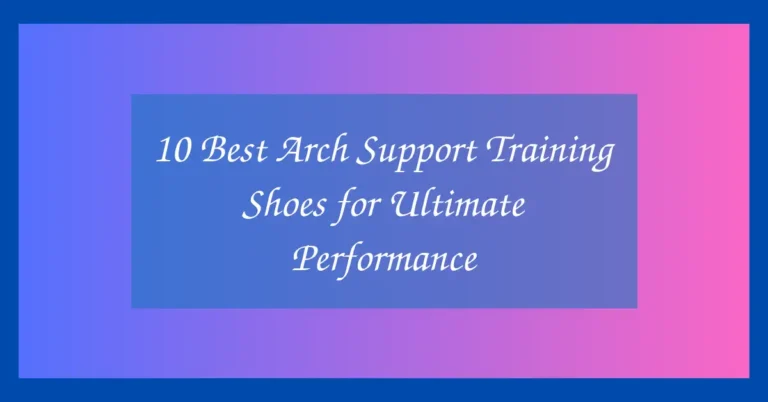Ultimate Guide to the 10 Best Cushioned Women’s Running Shoes: Comfort & Performance Unleashed
Finding the best cushioned women’s running shoes can make all the difference between a joyful run and a painful one. Cushioning plays a crucial role in shock absorption, protecting joints, and improving comfort for both casual joggers and long-distance runners. Our guide covers top picks that balance softness, responsiveness, and durability, making them ideal for all running styles.
In this article, we’ve selected shoes that prioritize underfoot comfort without compromising support or performance. Whether you’re training for a marathon or need something soft for daily miles, these options ensure a smooth, plush ride with each step.
Best Cushioned Women’s Running Shoes
1. HOKA ONE ONE Bondi 8
The HOKA Bondi 8 stands out as one of the most cushioned running shoes available. It features an ultra-plush midsole that provides excellent shock absorption for long distances. The shoe’s wide platform offers a stable base, which benefits runners who need more support during transitions.
Its redesigned foam and extended heel geometry allow smoother landings and better heel-to-toe transitions. Despite its thick cushioning, the Bondi 8 maintains a balanced ride without feeling overly soft or unstable. The engineered mesh upper also provides breathability and structure without adding weight.
This shoe works well for daily training, recovery runs, and even walking. Its oversized sole might not be for everyone, but for those seeking ultimate softness underfoot, the Bondi 8 delivers. It’s particularly great for runners with joint sensitivity or those recovering from injuries.
One area to note is that the shoe may feel bulky for faster-paced workouts. However, for endurance and comfort-focused runners, the plush experience is unmatched in this category.
Pros
- Maximum cushioning for long runs
- Smooth heel-to-toe transitions
- Breathable engineered mesh upper
Cons
- Bulky design for speed workouts
- May feel heavy for some runners
2. Brooks Glycerin 20
The Brooks Glycerin 20 is a neutral running shoe that offers a soft, luxurious feel underfoot. Featuring Brooks’ DNA LOFT v3 cushioning, this model delivers a responsive ride while maintaining excellent shock absorption. It’s designed for runners who want a plush experience without sacrificing energy return.
The upper uses a breathable engineered mesh that adapts well to the foot, while the redesigned midsole and outsole provide a smoother, more efficient ride. The shoe’s padding around the collar and heel also enhances comfort during longer sessions.
The Glycerin 20 is ideal for daily training, long runs, and easy paces. It’s particularly good for runners who value softness in the forefoot and heel. Its updated nitrogen-infused foam adds durability and bounce, helping runners maintain momentum even during longer distances.
Though it’s not the best choice for racing or tempo workouts, its combination of cushioning and durability makes it a versatile pick for everyday use. It suits both beginner and experienced runners looking for reliability and plush comfort.
Pros
- Plush DNA LOFT v3 cushioning
- Adaptable and breathable upper
- Great for daily and long-distance runs
Cons
- Not ideal for fast-paced runs
- Heavier than performance shoes
3. ASICS Gel-Nimbus 26
The ASICS Gel-Nimbus 26 continues to be a top-tier cushioned running shoe, updated with FF BLAST PLUS ECO cushioning and a softer engineered mesh upper. Designed for neutral runners, this shoe delivers enhanced shock absorption and a cloud-like feel for long-distance comfort.
It integrates ASICS’ signature GEL technology in the rear and forefoot, which minimizes impact on joints. The midsole offers a balanced feel soft on landing yet slightly responsive on toe-off. The heel fit and tongue padding have also been improved for a more secure fit.
This model is suitable for a wide range of runners, including those logging high weekly mileage or recovering from injuries. It’s particularly effective on hard pavement due to its soft platform and shock-dampening features.
The Nimbus 26 is not made for speed, and its heavier build reflects that. However, runners prioritizing protection and comfort over agility will appreciate its overall performance and support.
Pros
- Soft and eco-friendly cushioning
- Excellent shock absorption
- Comfortable, secure fit
Cons
- Not built for speed
- Price may be high for casual users
4. New Balance Fresh Foam X 1080v13
New Balance’s Fresh Foam X 1080v13 provides a premium cushioned experience, blending softness with support. Its Fresh Foam X midsole is designed to feel plush while offering a smooth ride for long runs and daily training alike.
The upper uses a Hypoknit material that delivers targeted stretch and support, adapting to various foot shapes. The shoe’s rocker profile enhances forward propulsion while minimizing impact, ideal for runners with joint sensitivity or heel strikers.
This model is especially popular among runners seeking versatility it works equally well for recovery runs, easy days, and longer efforts. It also offers solid heel lockdown and a roomy toe box, making it comfortable over extended periods.
Although not the lightest or most agile option, the 1080v13 balances cushioning and durability in a way that appeals to many training needs. Its comfort and adaptability make it a standout in the cushioned category.
Pros
- Plush yet responsive Fresh Foam X midsole
- Hypoknit upper offers great fit
- Versatile for multiple run types
Cons
- A bit bulky for faster workouts
- May feel wide for narrow feet
5. Nike ZoomX Invincible Run Flyknit 3
Nike’s ZoomX Invincible Run Flyknit 3 delivers one of the softest rides in the cushioned shoe category. Powered by ZoomX foam, the shoe feels energetic yet highly protective, making it ideal for long mileage and easy pace runners.
The Flyknit upper hugs the foot securely without restricting movement, and the wide midsole base enhances stability without sacrificing flexibility. The curved rocker geometry helps promote natural strides while reducing fatigue on joints and muscles.
This shoe is best suited for runners who want to reduce impact stress while maintaining an energized feel. It’s also favored by heavier runners needing additional cushioning underfoot. The outsole offers excellent grip, enhancing traction on both dry and slightly wet surfaces.
However, the soft foam may compress faster over time, especially for high-mileage runners. It’s not ideal for speed sessions but excels in providing all-day comfort for training and recovery runs.
Pros
- ZoomX foam offers supreme cushioning
- Great for daily training and recovery
- Stabilized ride with rocker design
Cons
- Foam may wear quicker with mileage
- Not suited for speed workouts
6. Saucony Triumph 21
The Saucony Triumph 21 is known for its luxurious PWRRUN+ cushioning, offering a soft yet responsive feel ideal for long-distance runners. It balances comfort and performance, making it suitable for high-mileage weeks and recovery days alike.
The updated upper features a redesigned flat-knit mesh that improves breathability and foot lockdown. The shoe offers a generous toe box and padded collar, enhancing comfort on extended runs. It also maintains a good heel fit without feeling restrictive.
Runners who prioritize long-run comfort and durability will appreciate the Triumph 21’s ride. It works well for neutral runners who want premium cushioning without compromising foot support. The rubber outsole adds traction and longevity, even on challenging terrains.
While the weight is slightly on the heavier side, the bounce-back feel makes up for it. It’s a dependable choice for daily training and long sessions where foot protection is key.
Pros
- Soft and bouncy PWRRUN+ foam
- Comfortable and breathable upper
- Durable for high-mileage training
Cons
- Heavier than lightweight trainers
- Less suited for fast paces
7. On Cloudmonster
The On Cloudmonster delivers a uniquely cushioned experience with its oversized CloudTec elements and Helion superfoam. This design provides a soft and responsive platform, offering both impact absorption and rebound for a smooth ride.
Its rocker-shaped sole encourages forward momentum and eases transitions. The shoe’s upper is lightweight and breathable, with a snug midfoot fit and padded tongue for added comfort. It’s especially beneficial for runners with joint concerns or those seeking post-injury support.
The Cloudmonster is great for daily mileage, long runs, and casual wear. Its visual design also appeals to runners who want style and performance in one package. The structured heel counter offers stability, while the roomy forefoot adds comfort on longer efforts.
However, the unique cushioning may feel different to runners used to traditional foams. It’s not ideal for racing or interval training but excels in plushness and fun factor during easy runs.
Pros
- Maximal CloudTec cushioning
- Excellent impact protection
- Rocker sole aids in transitions
Cons
- Cushioning feel may not suit everyone
- Not ideal for tempo or race workouts
8. Mizuno Wave Sky 7
The Mizuno Wave Sky 7 provides a plush and stable ride using its ENERZY CORE foam and Wave Plate technology. This combination offers softness without losing structure, giving runners comfort with every step.
The shoe features a wide platform for added stability and an engineered mesh upper that conforms nicely to the foot. The plush tongue and collar make it a joy to wear on longer runs. It’s an ideal shoe for daily training or long recovery sessions.
It suits runners who want cushioning without that “sinking” feeling. The midsole’s rebound properties also help preserve energy on longer outings, making it suitable for endurance runners and those with a heavier build.
Although it doesn’t feel fast or agile, the Wave Sky 7 excels in providing consistent cushioning, especially on hard surfaces. The outsole provides solid grip and wear resistance for long-term use.
Pros
- Soft and stable ENERZY CORE midsole
- Durable build with great grip
- Comfortable fit with roomy toe box
Cons
- Heavier than average
- Not responsive for speedwork
9. Adidas Ultraboost Light
The Adidas Ultraboost Light improves on its predecessor by using a lighter version of Boost foam. This update maintains the signature comfort and bounce of Ultraboost while making the shoe feel more agile on the run.
The Primeknit upper hugs the foot with a sock-like fit, offering breathability and support. Its flexible outsole provides solid grip across different surfaces, and the Torsion system enhances midfoot stability for added confidence on longer runs.
This shoe is perfect for runners who want a mix of style and substance. It performs well on daily runs and can double as a casual sneaker. The cushioning feels luxurious underfoot and works well for those who prioritize comfort.
While still not a racing shoe, the lighter build makes it more versatile than earlier Ultraboost models. It’s an ideal option for neutral runners who want performance cushioning with streetwear appeal.
Pros
- Lighter and more agile than previous models
- Soft and springy Boost foam
- Primeknit upper with secure fit
Cons
- Still not ideal for fast runs
- Fit may feel snug for wide feet
10. Altra Via Olympus
The Altra Via Olympus offers a zero-drop platform with maximum cushioning, ideal for runners seeking a natural stride with plush underfoot feel. Its EGO MAX midsole provides both softness and rebound, reducing fatigue during longer runs.
The FootShape toe box allows toes to splay naturally, enhancing comfort and reducing pressure on the forefoot. The upper is breathable and reinforced in key areas to provide support without adding bulk. The overall build feels stable despite its high stack height.
This shoe works best for runners who prefer a low-drop or natural ride. It’s particularly helpful for forefoot or midfoot strikers who want cushioning without sacrificing foot alignment. The wide base adds security on uneven paths.
Though it’s not ideal for speed training or racing, the Via Olympus stands out for injury prevention, daily training, and recovery sessions. It’s a unique option in the cushioned shoe segment for those seeking a foot-shaped fit and balance-focused design.
Pros
- Zero-drop for natural stride
- Plush EGO MAX cushioning
- Spacious FootShape toe box
Cons
- Not suited for racing
- Unusual feel for new users
| Product Name | Cushioning Type | Best Use | Stability | Weight Level |
|---|---|---|---|---|
| HOKA ONE ONE Bondi 8 | Ultra Plush EVA | Long Distance | High | Heavy |
| Brooks Glycerin 20 | DNA LOFT v3 | Daily Trainer | Moderate | Moderate |
| ASICS Gel-Nimbus 26 | FF BLAST PLUS | Recovery Run | High | Heavy |
| New Balance 1080v13 | Fresh Foam X | Mixed Training | Moderate | Moderate |
| Nike ZoomX Invincible 3 | ZoomX Foam | Recovery Run | High | Light |
| Saucony Triumph 21 | PWRRUN+ | Long Mileage | Moderate | Heavy |
| On Cloudmonster | CloudTec Helion | Easy Miles | Moderate | Moderate |
| Mizuno Wave Sky 7 | ENERZY Core | Recovery Run | High | Heavy |
| Adidas Ultraboost Light | Boost Light Foam | Urban Running | Moderate | Light |
| Altra Via Olympus | EGO MAX | Natural Running | High | Heavy |
Best Cushioned Women’s Running Shoes Buying Guide
Fit and Comfort
Proper fit is crucial for any running shoe, especially cushioned ones. A snug heel, spacious toe box, and midfoot support ensure the shoe molds to your foot naturally. Look for soft linings, padded collars, and flexible uppers that allow natural foot movement without chafing.
Cushioning Type
Different brands use different foam technologies. Some offer soft, pillow-like cushioning while others balance softness with bounce. EVA-based foams like HOKA and nitrogen-infused foams like Brooks DNA LOFT provide varying ride experiences. Choose cushioning based on your mileage, terrain, and personal comfort preference.
Drop and Stack Height
Heel-to-toe drop impacts how your foot strikes the ground. A higher drop suits heel strikers, while a zero-drop encourages forefoot landing. Stack height determines how much cushioning is underfoot. Higher stacks mean more shock absorption but less ground feel.
Stability vs Neutral
If you overpronate, consider cushioned stability shoes. They support inward roll while still offering plush midsoles. Neutral runners can go for standard cushioned models. Some shoes offer wide platforms and rocker soles for added balance and smoother transitions.
Durability and Mileage
Cushioned shoes may wear faster depending on foam type and usage. Look for rubber outsoles and resilient midsoles if you plan to run over 200–300 miles. High-mileage runners should avoid ultra-soft foams that compress quickly without spring-back.
Use Case: Training, Recovery, or Racing
Some shoes are designed specifically for recovery, daily training, or long runs. Lightweight cushioned shoes may be good for tempo days, but maximal cushioning is usually best for easy and recovery runs. Match your shoe choice to your intended run type.
FAQ
Are cushioned running shoes better for beginners?
Cushioned running shoes are often ideal for beginners. They reduce joint impact and help smooth the landing, which is especially important when building mileage or running on pavement. Beginners benefit from the added comfort and forgiveness these shoes offer.
Can cushioned shoes help prevent injuries?
Yes, the added shock absorption in cushioned shoes helps minimize stress on joints, which can reduce the risk of injuries like shin splints or knee pain. However, proper running form and training still play a crucial role in injury prevention.
Are cushioned running shoes suitable for speed training?
Most cushioned running shoes are designed for comfort, not speed. While some offer responsive foams for tempo runs, many are too soft or heavy for sprints and intervals. Runners often switch to lighter, firmer shoes for speed workouts or races.
What’s the difference between plush and responsive cushioning?
Plush cushioning focuses on softness and impact absorption. Responsive cushioning still feels soft but offers more energy return and bounce. The choice depends on whether you want a smooth glide or a snappy toe-off during your runs.
Do cushioned shoes work well for walking?
Absolutely. Many cushioned running shoes are excellent for walking due to their softness and support. Models like HOKA Bondi and Brooks Glycerin are often recommended for all-day wear, walking, or standing on hard surfaces for long periods.
How long do cushioned running shoes last?
On average, cushioned running shoes last between 250 and 400 miles. The lifespan depends on the foam material, runner weight, running style, and terrain. Softer foams may compress faster, while denser midsoles typically hold their shape longer.
Verdict
Choosing the best cushioned women’s running shoes depends on your personal comfort needs, running style, and training goals. Whether you prioritize plush softness for recovery, responsive cushioning for daily runs, or a stable base for joint protection, this list offers a suitable option. Test what fits your stride best and enjoy the run in comfort and confidence.







